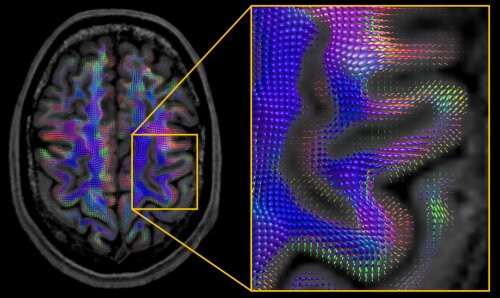Super-resolution reconstruction for fast and quantitative MRI
At the University of Antwerp, a super-resolution acquisition and reconstruction approach for Magnetic Resonance Imaging (MRI) is developed that allows reconstruction of high-resolution images or parameter maps from multiple low-resolution images. This technology can be used by companies developing MRI systems or MRI analysis service providers.

Situation before
Quantitative MRI (qMRI) allows for absolute quantification and mapping of biophysical tissue properties, thus enabling discrimination between tissue types for more accurate diagnosis. Unfortunately, clinical adoption of qMRI methods is lagging behind, mainly due to its long scan time requirements. The root cause of these long scan times is the acquisition of multiple contrast weighted images that are required to extract quantitative parametric maps with adequate accuracy, precision, and spatial resolution.
Technology
We developed an accelerated super-resolution acquisition and reconstruction approach for MR images that allows high-resolution images or parameter maps (diffusion, T1, T2, …) to be calculated from multiple low-resolution images. By a fast acquisition and smart combination of multiple thick image slices, we can reconstruct high-resolution MR images with improved image quality, precision and accuracy, which leads to higher statistical power. The super-resolution reconstruction (SRR) framework can be integrated in software platforms of MRI systems such that it can be used in routine clinical practice of radiology departments as already successfully demonstrated for the knee and brain [Ref below]. However, it can be applied on any part of the body.
Partners we search for
Thanks to the generic nature of the (q)MRI-SRR framework, MRI system providers can implement the framework in their MRI systems for anatomical as well as quantitative imaging. In addition, (q)MRI analysis service providers will benefit from accelerated (q)MRI technology to improve the image quality using existing (or slightly adapted) low resolution MRI acquisition protocols. Furthermore, we are interested in collaborations with industrial partners to continue demonstrating the method.
About the researchers
The long-term research of imec-VisionLab aims at the development of advanced statistical techniques for the processing and analysis of (medical) images. This includes model based statistical and multi resolution techniques, with applications in image reconstruction, restoration, segmentation and classification. They are internationally recognized for their expertise in i.a. biomedical imaging.
IP Position
Patent application ‘DIFFUSION MRI COMBINED WITH A SUPER-RESOLUTION IMAGING TECHNIQUE' published under number WO2019228719 and introduced in following jurisdictions: Europe, USA, China and South-Korea.
References: Poot D.H.J., B. Jeurissen, Y. Bastiaensen, J. Veraart, W. Van Hecke, P.M. Parizel, J. Sijbers, “Super-resolution for multislice diffusion tensor imaging,” Magnetic Resonance in Medicine, Vol. 69, pp. 103-113, 2013. doi: 10.1002/mrm.24233
Van Dyck, P., C. Smekens, F. Vanhevel, E. De Smet, E. Roelant, J. Sijbers, and B. Jeurissen, “Super-Resolution Magnetic Resonance of the Knee Using 2-Dimensional Turbo Spin Echo Imaging”, Investigative Radiology, Vol. 55 (8), pp. 481-493, 2020. doi: 10.1097/RLI.0000000000000676
Van Steenkiste, G., B. Jeurissen, J. Veraart, A.J. den Dekker, P.M. Parizel, D.H.J. Poot, and J. Sijbers, “Super- Resolution Reconstruction of Diffusion Parameters from Diffusion-Weighted Images with Different Slice Orientations.”, Magnetic Resonance in Medicine, Vol. 75 (1), pp. 181-195, 2016. doi: 10.1002/mrm.25597
More information
University of Antwerp
Valorisation Office
Middelheimlaan 1
2020 Antwerp - Belgium
Phone: +32 3 265 30 25